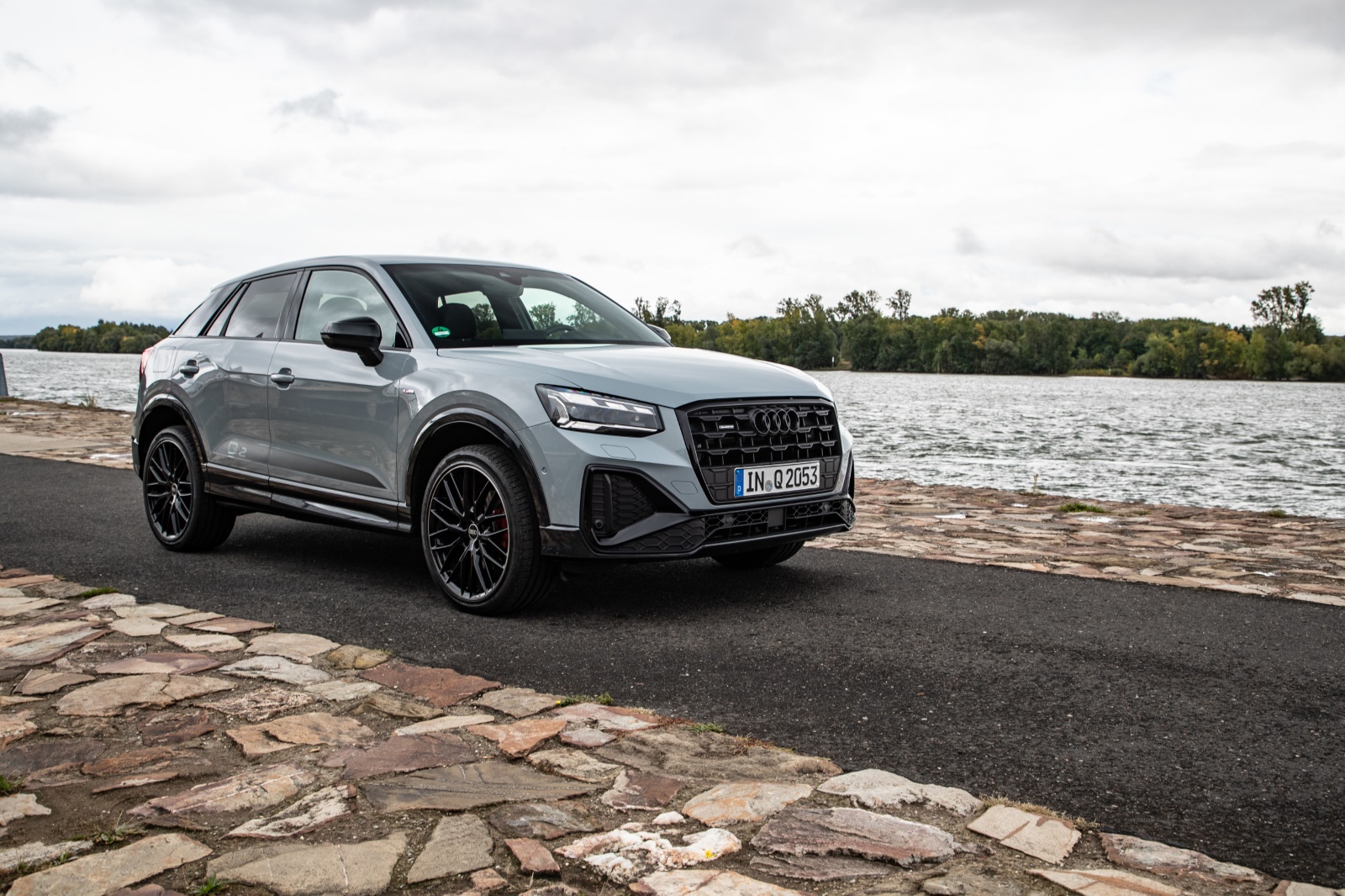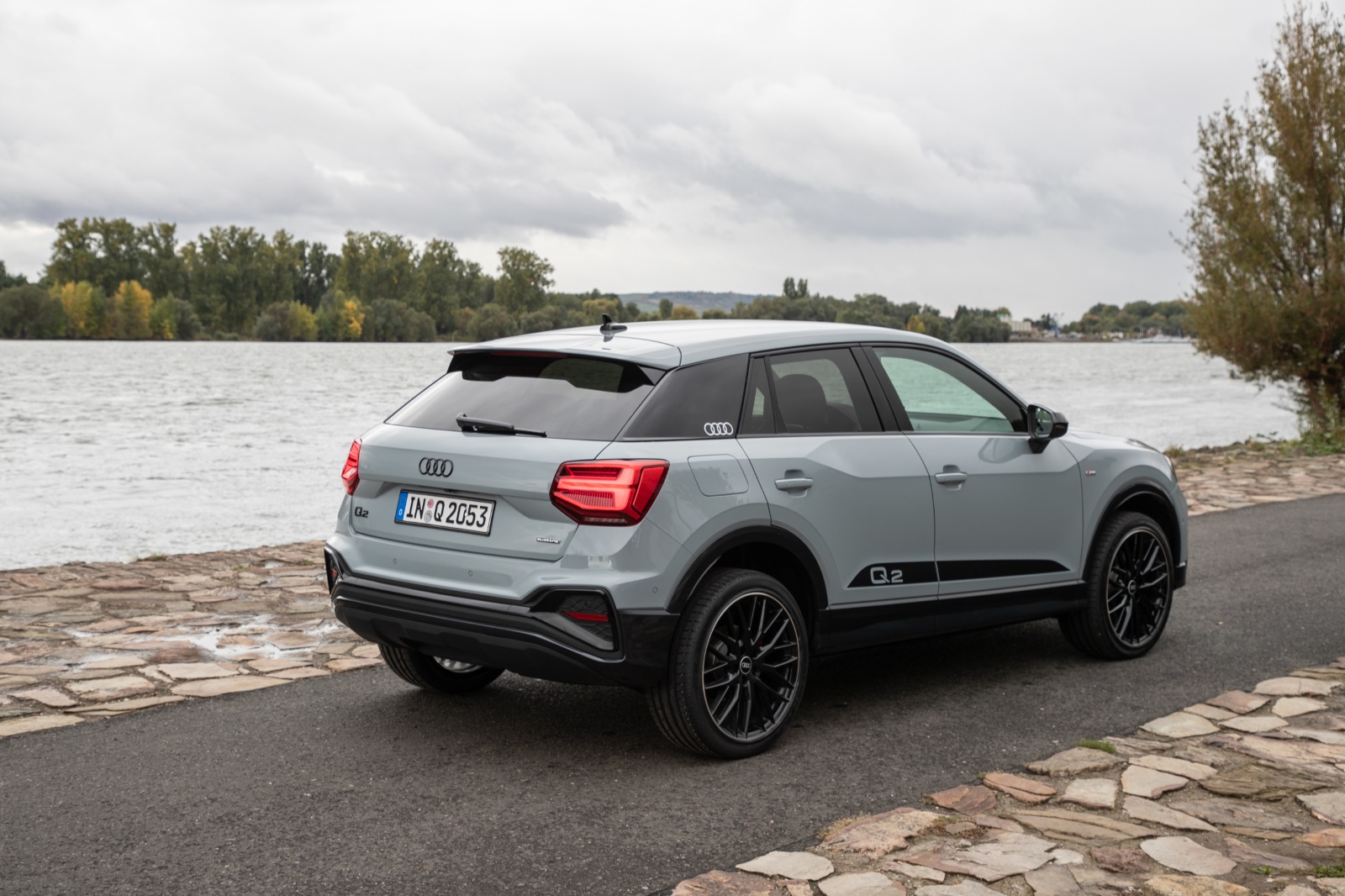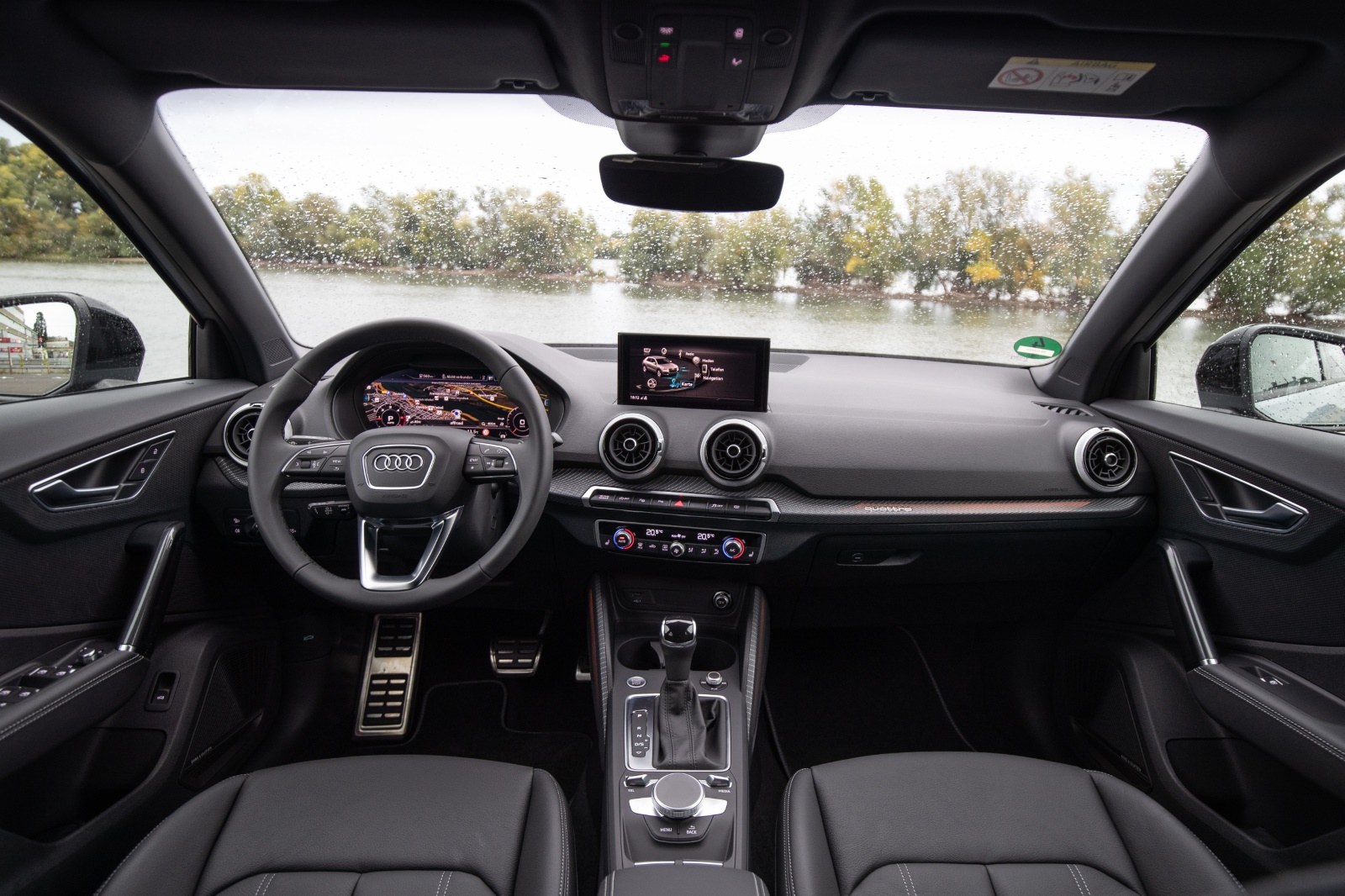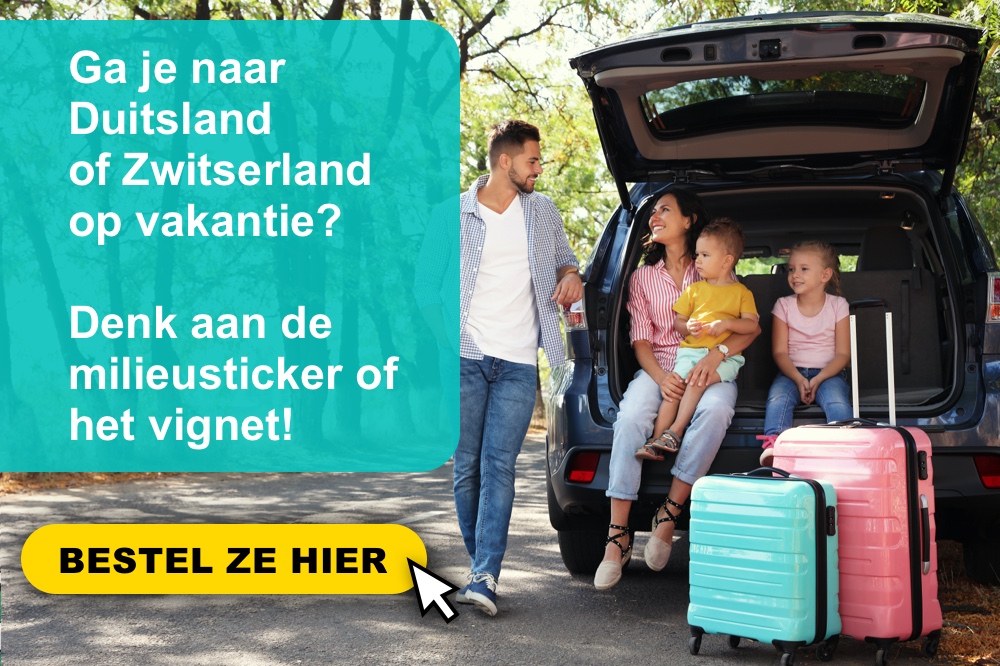Table of Contents
Audi Q2
Q2 -
This Audi Q2 comes from 2023 and then cost € 47,162.-. This imported passenger car has been on registration since 2024, is equipped with a petrol motor, has a maximum power of 110 kW (150 hp) and a cylinder capacity of 1498 cc.
This passenger car has a top speed of 218 km/h and reaches the 100 km/h in 8.6 seconds from standstill. The consumption of this passenger car is on average 6.1 liters per 100 km and it weighs 1280 kg. The APK is valid until 24-04-2027 and the road tax is on average € 198.25 per quarter.
View all data
This passenger car has a top speed of 218 km/h and reaches the 100 km/h in 8.6 seconds from standstill. The consumption of this passenger car is on average 6.1 liters per 100 km and it weighs 1280 kg. The APK is valid until 24-04-2027 and the road tax is on average € 198.25 per quarter.
Value indication
€ 32-38kAPK expiry date
24-04-20270-100 km/h
8.6 sec.Top speed
218 km/hNumber of owners
1 (2 incl. car companies)Taxi?
NeeConstruction Year
2023Imported?
JaFirst national admission
17-05-2024First international admission
24-04-2023International damage history
Want to know if a car has had damage? Check it for free in our worldwide damage database.
Engine capacity
1,498 cm³
Top speed
218 km/h
Amount of cylinders
4
Engine code
DXD
Power
110 kW (150 hp)
G3
Nee
Propulsion
Voorwiel
Wheel base
260 cm
Torque
250 Nm
Tank volume
50 liter
Max. RPM
5,000 rpm
Max. torque per RPM
1,500 rpm
Turbo / Compressor
Ja
Acceleration 0-100
8.60 seconds
Location VIN-Number
Unknown
Approval number type
e1*2007/46*1552*34
Weight
1,280 kg
Weight when drive ready
1,380 kg
Max. weight
1,870 kg
Max. pulling weight
690 kg
Max. pulling weight braked
1,500 kg
Length
4,216 mm
Width
1,802 mm
Height
1,548 mm
Amount of seats
5
Amount of tires
4
Axles
Number of axles
2
Axle number: 1
Position code: V (Front axle)
Propelled axle: Yes
Technically permissible max. load: 1,000 kg
Legally permissible max. load: 1,000 kg
Propelled axle: Yes
Technically permissible max. load: 1,000 kg
Legally permissible max. load: 1,000 kg
Axle number: 2
Position code: A (Rear axle)
Propelled axle: No
Technically permissible max. load: 960 kg
Legally permissible max. load: 960 kg
Propelled axle: No
Technically permissible max. load: 960 kg
Legally permissible max. load: 960 kg
17-05-2024
This vehicle has been imported to the Netherlands.
Vehicle is registered by a private owner.
28-03-2024
New owner type:
Vehicle is registered by a car company.
24-04-2023
New owner type:
Vehicle is registered by an unknown entity.
Owner overview
An overview of all owner changes this vehicle has had. The owner shown is the owner registered at the time of registration. This is fixed data and cannot be changed afterwards.
Unknown owner(s)
24-04-2023 - 28-03-2024
Car company
28-03-2024 - 17-05-2024
Private owner
17-05-2024 - Now
Vehicle state overview
Number of owners
1 (2 incl. car companies)
Current owner
Private owner
WAM insured
Ja
First national admission
17-05-2024
First international admission
24-04-2023
Date of liability
17-05-2024
Parallelly imported
Ja
APK expiration date
24-04-2027
License state
Valid
Exported
Nee
Demolished
Nee
Invalid
Nee
APK expiry date
24-04-2027
APK findings
None
Maintenance regististration(s)
None
Registered APK repairs for Audi - Q2
None
Callback campaigns
None
Common repairs
There is not enough data available about this car to show a reliable result for the common repairs.
Unlock all options and accessories for this car. For example:
• Anti Blocking System
• Airbag on the drivers side
• Central locking system
• Electronic Stability Program
• Hill hold functie
• Multimedia-prepared
• Radio-CD/MP3 player
• Start/stop system
• Alarm class 1
• Airbag on the drivers side
• Central locking system
• Electronic Stability Program
• Hill hold functie
• Multimedia-prepared
• Radio-CD/MP3 player
• Start/stop system
• Alarm class 1
Get missing premium data for this Audi - Q2
There are 8 important data points you are missing.
Advertisement history
Auto offered for sale. Buy premium report to discover the full overview. Incl. price and odometer reading.Wacht Op Keuren (WOK)
Find out if this vehicle meets the legal requirements or if it still needs to wait for an inspection.Odometer history
1 odometer reading reported for this auto. Buy the premium report to unlock the full odometer history.Options and accessories
All options and accessories that apply to the car. No need to guess with a Premium report.Total cost of ownership
Get personalised monthly costs for maintenance, write off, fuel, tires, insurance and road tax.Current value
With the current value of the car, you know exactly where you stand. Whether you buy or sell a car.Statistics
Statistics give information about the average number of idle days, the number of new or as occasions sold in the past year, and much more!Theft check
See how many of these vehicles have been stolen in the last year and what our prediction is for the coming year. Plus more!
Request the following personalised costs:
• Maintenance costs
• Write off costs
• Fuel costs
• Tire costs
• Insurance costs
• Road tax costs
• Total monthly costs
• Write off costs
• Fuel costs
• Tire costs
• Insurance costs
• Road tax costs
• Total monthly costs
New price
€ 47,162.-
Value indication
€ 32-38k
BPM
€ 4,922.-
Rest BPM
€ 2,806.-
Addition class
22%
Net addition
- 36.93%: € 319.31
- 49.50%: € 428.00
Road taxes per quarter
- Drenthe: € 202.-
- Flevoland: € 195.-
- Friesland: € 200.-
- Gelderland: € 207.-
- Groningen: € 205.-
- Limburg: € 195.-
- N-Brabant: € 194.-
- N-Holland: € 190.-
- Overijssel: € 194.-
- Utrecht: € 194.-
- Z-Holland: € 207.-
- Zeeland: € 196.-
Market value history
1 Asking price publications
1 asking price publication(s) for this vehicle.
Purchase the premium report and receive an overview of the asking price publication(s)
Purchase the premium report and receive an overview of the asking price publication(s)
Unlock the following statistics:
• Average amount of idle days
• Average amount of days the car was owned
• Amount of newly sold cars the last 12 months
• Amount of occassions sold the last 12 months
• Total amount registered
• Average demolished after
• Average exported after
• Average amount of days the car was owned
• Amount of newly sold cars the last 12 months
• Amount of occassions sold the last 12 months
• Total amount registered
• Average demolished after
• Average exported after
Brand
Audi
Model
Q2
Make
35 TFSI S Edition
Construction Year
2023
Fuel type
Petrol
Color
Grijs
Color 2
Niet van toepassing
Vehicle classification
Personenauto
Layout
Stationwagen
Vehicle type
SUV
Number of doors
5
Transmission
Automatic
Number of gears
7
Segment
R (Mini-SUV)
SCM alarm certificate
Unknown
Avg. fuel consumption
1 in 16.4 (6.1 l/100 km)
Fuel consumption on outside roads
Not registered
Fuel consumption in the city
Not registered
CO2 Emissions
Not registered
CO2 Combinationride WLTP
138 g/km
Nitrogen oxide emissions (NOₓ) NEDC
0.0 mg/km
Emission classification
6
Energylabel
Unknown
Euro classification
Euro 6
Carbon filter
N/A
Noise level stationairy
82 dB(A)
Noise level torque stationairy
3,750 rpm
Noise level driving
0 dB(A)
Environment sticker in Germany
Groen
Environment zones
The municipality of 's Hertogenbosch has an environmental zone as of September 1, 2007. The environmental zone includes the old inner city, 't Zand and the area between the Zuid-Willemsvaart and the Aa.
The municipality of Amsterdam has an environmental zone as of October 9, 2008. The Amsterdam environmental zone includes the area within the Ring A10 with a few exceptions. District Amsterdam-North is exempted because there are no air quality issues here. The business parks RAI, De Schinkel, Cruquius, Amstel and Amstel Business Park are exempt because the freight traffic that comes here usually has no destination elsewhere in the city.
Since 1 January 2018, an environmental zone applies to:
- mopeds and motorcycles. It concerns 2-stroke and 4-stroke mopeds and motorcycles with a DET from before January 1, 2011. Mopeds, scooters or light-mopeds with a Date of First Authorization (DET) from 2010 or older may no longer be driven in built-up areas.
- Cabs (M1 vehicle code and cab registration with RDW) with a diesel engine and a Date of First Admission (DET) from 2008 or older. The environmental zone applies to all cabs, even those not registered in Amsterdam must meet the requirements before entering the environmental zone.
Since November 2020, a green environmental zone has applied within Amsterdam for passenger cars with diesel engines. Diesel passenger cars may only enter the environmental zone if they have emission class 4 or higher. Diesel cars with an emission class 3 or lower are no longer allowed. Cars that do not run on diesel are welcome in the environmental zone.
Within Amsterdam, a green environmental zone applies to:
- Diesel trucks. This means that trucks with a diesel engine may only enter the environmental zone if they have emission class 4 or higher. Trucks that do not run on diesel are also welcome in the environmental zone. Trucks with a diesel engine and an emission class 3 or lower do not have access.
- Diesel delivery vans. This means that only delivery vans with a diesel engine and an emission class 4 or higher may enter the environmental zone. The municipality will therefore no longer use the Date of First Admission (DET) as a basis. Non-diesel delivery vans remain welcome. Delivery vans with a diesel engine and an emission class 3 or lower no longer have access.
- Autobuses that run on diesel. This means that diesel-powered autobuses may only enter the environmental zone if they have emission class 4 or higher. The municipality therefore no longer bases itself on the DET. Non-diesel buses remain welcome in the environmental zone. Buses with a diesel engine and emission class 3 or lower no longer have access.
As of January 1, 2022, the environmental zone will be tightened. Then diesel buses and coaches will only have access with emission class 6 and higher.
- Diesel vehicles, even if they are registered as campers. This means that only vehicles with a diesel engine and an emission class 4 or higher may enter the environmental zone. The municipality will therefore no longer use the Date of First Admission (DET) as a basis. Non-diesel vehicles remain welcome. Vehicles with a diesel engine and an emission class 3 or lower no longer have access.
NB: the dispensation policy of the municipality of Amsterdam states that special vehicles are exempt (provided they are not older than 13 years). You therefore no longer need an exemption from RVO.nl to gain access to the Amsterdam environmental zone. You also do not need to apply for an exemption from the municipality of Amsterdam. In practice, nothing changes for you.
For the same reason Amsterdam is missing from the list of cities in the 'Notification of Exemptions for Environmental Zones' for which RvO grants exemptions.
Since 1 January 2018, an environmental zone applies to:
- mopeds and motorcycles. It concerns 2-stroke and 4-stroke mopeds and motorcycles with a DET from before January 1, 2011. Mopeds, scooters or light-mopeds with a Date of First Authorization (DET) from 2010 or older may no longer be driven in built-up areas.
- Cabs (M1 vehicle code and cab registration with RDW) with a diesel engine and a Date of First Admission (DET) from 2008 or older. The environmental zone applies to all cabs, even those not registered in Amsterdam must meet the requirements before entering the environmental zone.
Since November 2020, a green environmental zone has applied within Amsterdam for passenger cars with diesel engines. Diesel passenger cars may only enter the environmental zone if they have emission class 4 or higher. Diesel cars with an emission class 3 or lower are no longer allowed. Cars that do not run on diesel are welcome in the environmental zone.
Within Amsterdam, a green environmental zone applies to:
- Diesel trucks. This means that trucks with a diesel engine may only enter the environmental zone if they have emission class 4 or higher. Trucks that do not run on diesel are also welcome in the environmental zone. Trucks with a diesel engine and an emission class 3 or lower do not have access.
- Diesel delivery vans. This means that only delivery vans with a diesel engine and an emission class 4 or higher may enter the environmental zone. The municipality will therefore no longer use the Date of First Admission (DET) as a basis. Non-diesel delivery vans remain welcome. Delivery vans with a diesel engine and an emission class 3 or lower no longer have access.
- Autobuses that run on diesel. This means that diesel-powered autobuses may only enter the environmental zone if they have emission class 4 or higher. The municipality therefore no longer bases itself on the DET. Non-diesel buses remain welcome in the environmental zone. Buses with a diesel engine and emission class 3 or lower no longer have access.
As of January 1, 2022, the environmental zone will be tightened. Then diesel buses and coaches will only have access with emission class 6 and higher.
- Diesel vehicles, even if they are registered as campers. This means that only vehicles with a diesel engine and an emission class 4 or higher may enter the environmental zone. The municipality will therefore no longer use the Date of First Admission (DET) as a basis. Non-diesel vehicles remain welcome. Vehicles with a diesel engine and an emission class 3 or lower no longer have access.
NB: the dispensation policy of the municipality of Amsterdam states that special vehicles are exempt (provided they are not older than 13 years). You therefore no longer need an exemption from RVO.nl to gain access to the Amsterdam environmental zone. You also do not need to apply for an exemption from the municipality of Amsterdam. In practice, nothing changes for you.
For the same reason Amsterdam is missing from the list of cities in the 'Notification of Exemptions for Environmental Zones' for which RvO grants exemptions.
The municipality of Arnhem has an environmental zone for freight traffic as of 1 July 2014. The Arnhem environmental zone covers the area within the Arnhem center ring, including the center ring itself.
The municipality of Breda has an environmental zone as of October 4, 2007. The environmental zone covers the inner side of the canals.
The Tramsingel, Oranjesingel, Wilhelminasingel and the Fellenoordstraat are accessible for all freight traffic.
The Tramsingel, Oranjesingel, Wilhelminasingel and the Fellenoordstraat are accessible for all freight traffic.
The municipality of Delft has an environmental zone as of January 1, 2010.
The environmental zone roughly covers the area southeast of Delft's inner city. In this way the environmental zone contributes to improving the air quality in this area. The environmental zone is situated in such a way that it covers the air quality bottlenecks and prevents shortcuts through residential areas.
The environmental zone roughly covers the area southeast of Delft's inner city. In this way the environmental zone contributes to improving the air quality in this area. The environmental zone is situated in such a way that it covers the air quality bottlenecks and prevents shortcuts through residential areas.
From January 1, 2022, only trucks and buses with emission class 6 and vehicles that do not emit harmful substances may drive in the environmental zone. Until January 1, 2022, the environmental zone is still allowed for:
- Trucks with emission class 4 or higher.
- Special vehicles that are not older than 13 years.
The environmental zone lies within the Centrumring (S100) and the Telderstracé (S200).
From 1 July 2021 the following areas are also covered by the environmental zone:
- the area north of Javastraat/Laan van Meerdervoort within the Telderstracé.
- The area south of Waldorpstraat, Rijswijkseplein, and Weteringkade to the Centrumring.
The following roads are outside the environmental zone:
- The Centrumring and the Telderstracé itself.
- The road from the Lijnbaan to the parking lot and garage of the hospital HMC Westeinde.
NB: the exemptions policy of the Municipality of The Hague states that special vehicles are exempt (provided they are not older than 13 years). You therefore no longer need an exemption from RVO.nl to access The Hague's environmental zone. You also do not need to apply for an exemption from the municipality of The Hague. In practice, nothing changes for you.
- Trucks with emission class 4 or higher.
- Special vehicles that are not older than 13 years.
The environmental zone lies within the Centrumring (S100) and the Telderstracé (S200).
From 1 July 2021 the following areas are also covered by the environmental zone:
- the area north of Javastraat/Laan van Meerdervoort within the Telderstracé.
- The area south of Waldorpstraat, Rijswijkseplein, and Weteringkade to the Centrumring.
The following roads are outside the environmental zone:
- The Centrumring and the Telderstracé itself.
- The road from the Lijnbaan to the parking lot and garage of the hospital HMC Westeinde.
NB: the exemptions policy of the Municipality of The Hague states that special vehicles are exempt (provided they are not older than 13 years). You therefore no longer need an exemption from RVO.nl to access The Hague's environmental zone. You also do not need to apply for an exemption from the municipality of The Hague. In practice, nothing changes for you.
The municipality of Eindhoven has an environmental zone as of July 1, 2007. The Eindhoven environmental zone includes the area within the ring road (postal code area 5611 to 5616), with the exception of business park De Kade.
The municipality of Leiden has an environmental zone as of January 1, 2010. The Leiden environmental zone includes the area within the singels and the eastern part of the Morsweg.
The municipality of Maastricht has an environmental zone as of March 1, 2010. The environmental zone includes the Statensingel.
The municipality of Rijswijk has an environmental zone as of November 1, 2010. The Rijswijk environmental zone includes the area between Burgemeester Elsenlaan, the city borders with The Hague and Voorburg, De Vliet to Prunuskade and via Handelskade to Burgemeester Elsenlaan. Part of the Rotterdamseweg, up to the Laan van Oversteen, also falls within the zone.
The municipality of Rotterdam has an environmental zone as of September 16, 2007. Until recently, the Rotterdam environmental zone broadly covered the Central station district, the Stadsdriehoek, the Oude Westen and the Cool district.
As of 1 January 2016, the municipality of Rotterdam expanded the environmental zone. The zone has become larger. The environmental zone lies roughly within the 'diamond' of Rotterdam, on the north side of the Maas River. The environmental zone lies in the center and north of the city, between the A20, the A16, the Nieuwe Maas and the S114 (Tjalklaan, Vierhavenstraat, Westzeedijk). The three riverbank connections Maastunnel, Erasmusbrug and Willemsbrug (including Noordereiland) are also in the environmental zone. On the map below, the black line indicates the boundary of the environmental zone.
In addition to the geographical expansion, the environmental zone also applies to delivery vans and passenger cars.
NB: the exemption policy of the municipality of Rotterdam states that special vehicles are exempt (provided they are not older than 13 years). You therefore no longer need an exemption from RVO.nl to enter the Rotterdam environmental zone. You also do not need to apply for an exemption from the Municipality of Rotterdam. In practice, nothing changes for you.
For the same reason Rotterdam is missing from the list of cities in the 'Notification on Exemptions for Environmental Zones' for which RvO grants exemptions.
As of 1 January 2016, the municipality of Rotterdam expanded the environmental zone. The zone has become larger. The environmental zone lies roughly within the 'diamond' of Rotterdam, on the north side of the Maas River. The environmental zone lies in the center and north of the city, between the A20, the A16, the Nieuwe Maas and the S114 (Tjalklaan, Vierhavenstraat, Westzeedijk). The three riverbank connections Maastunnel, Erasmusbrug and Willemsbrug (including Noordereiland) are also in the environmental zone. On the map below, the black line indicates the boundary of the environmental zone.
In addition to the geographical expansion, the environmental zone also applies to delivery vans and passenger cars.
NB: the exemption policy of the municipality of Rotterdam states that special vehicles are exempt (provided they are not older than 13 years). You therefore no longer need an exemption from RVO.nl to enter the Rotterdam environmental zone. You also do not need to apply for an exemption from the Municipality of Rotterdam. In practice, nothing changes for you.
For the same reason Rotterdam is missing from the list of cities in the 'Notification on Exemptions for Environmental Zones' for which RvO grants exemptions.
The municipality of Tilburg has had an environmental zone since September 1, 2007. The Tilburg environmental zone covers the area within the ring road.
The municipality 's Utrecht has an environmental zone as of 1 July 2007. The environmental zone covers the entire inner city, the station area, the Jaarbeurs and some adjacent roads.
Stickers
Rating by Autozine
Review with pros and cons

Positives
- Serieus snel
- Even praktisch als een gewone audi q2
- Comfortabel
Negatives
- Karige basisuitrusting
- Helt nadrukkelijk over in bochten
- Merkbaar zwaar bij hard remmen
De Audi SQ2 is een sportieve, compacte SUV. De prestaties zijn uitstekend, maar de SQ2 verraadt ook dat een SUV geen goed uitgangspunt is voor een snelle auto. Waarom moeilijk als het makkelijk kan?
Avg. 873 days owned per owner
3,246,075 vehicles with the same color
44% of the owners are female
9,483,671 vehicles are older than this car
There are 15,270 vehicles of this brand/model in NL
Last year there were 2,113 vehicles of the same edition in NL
1,630,892 vehicles are faster or have more hp
The average owner is 53 years old
This license has been spotted 12 times
Buy this type of car (591 options)
Sell your car
Finance this car
• 1 in 5 cars have an above average or high risk of theft
• 1 in 1000 cars built in the last 10 years is stolen in the past year
• 1 in 1000 cars built in the last 10 years is stolen in the past year








